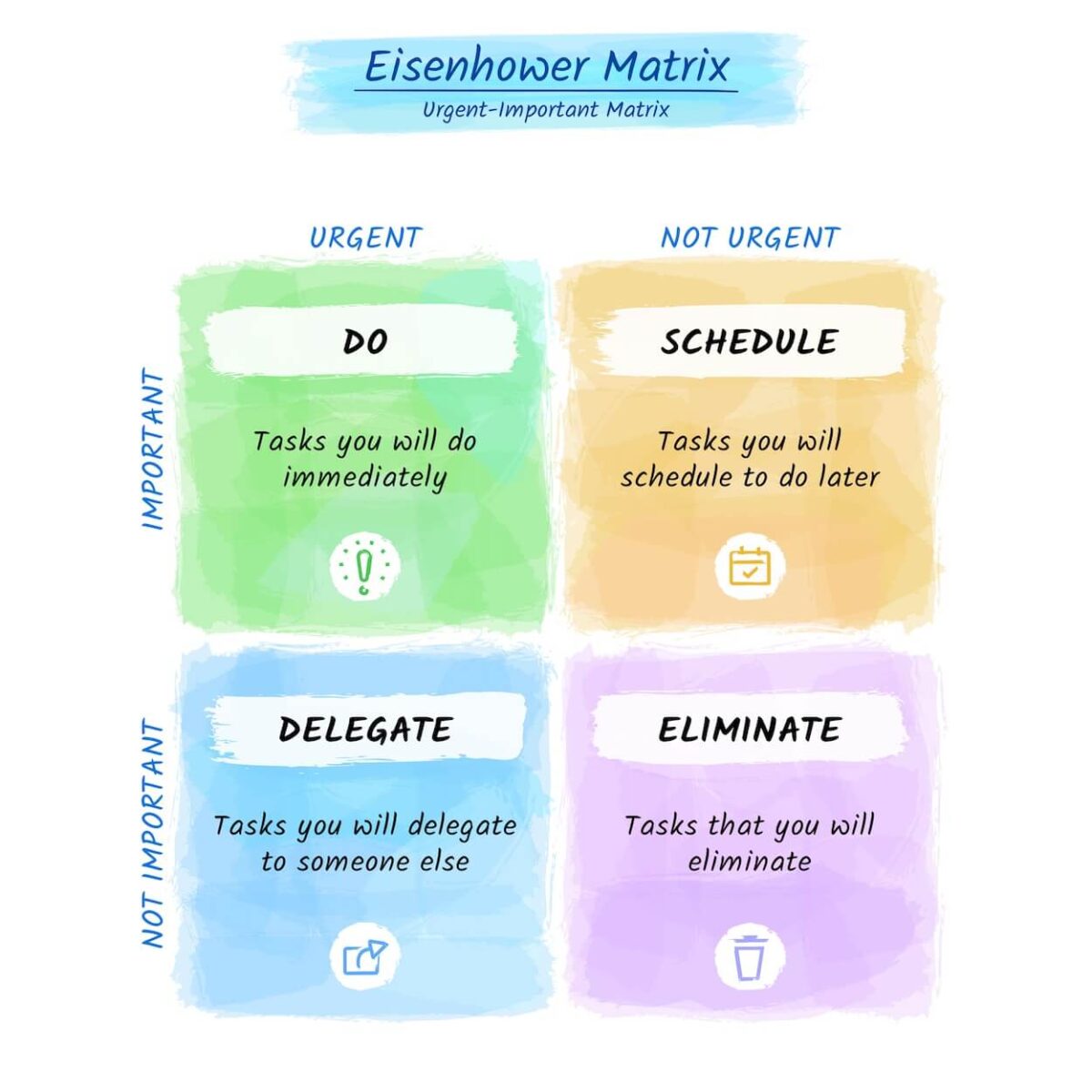How To Define Your Life Priorities & Why It Matters
Life can often feel like a juggling act, with numerous responsibilities and aspirations all competing for our attention. Determining what truly matters with all this background noise can be challenging, yet essential for a fulfilling and balanced life. This guide will help you identify your top life priorities and recognise those things that don’t deserve your time.
Why Identifying Life Priorities is Important
Understanding your priorities in life is the foundation of effective time management and personal fulfilment. It’s about aligning your daily actions with your long-term goals and values, ensuring that you invest your time and energy where it matters most.
The last thing any of us wants to do is spend all our time and energy on something that isn’t even really meaningful.
The Impact of Misaligned Priorities
When your priorities are not aligned with your actions, you can experience stress, burnout, and dissatisfaction – the dreaded life slump. And this isn’t just about being in a job you love. This misalignment can relate to every aspect of your life and can drastically impact your personal happiness.
How to Identify Your Top Priorities In Life
Determining your top life priorities requires introspection and honest evaluation. Here are the steps to help you identify what matters most to you:
1. Reflect on Your Core Values
Core values are the fundamental beliefs and principles that guide your behaviour and decision-making. They represent what is most important to you in life. They should be the basis of everything because when we aren’t aligned without core values, our happiness can suffer drastically.
Common core values include integrity, compassion, family, growth, and health.
Exercise: Find Your Core Values
- List Your Values: Start by listing values that resonate with you. Think about moments when you felt fulfilled and proud—what values were you honouring?
- Rank Your Values: Once you have a list, rank these values in order of importance. It’s crucial to be honest and introspective during this process. Take your time.
2. Assess Your Current Commitments
Take a close look at how you’re currently spending your time. Are your daily activities aligned with your values and long-term goals? This assessment will help you identify discrepancies and areas that need adjustment.
Reflect on how well your current life aligns with your top core values. Are you dedicating enough time and energy to the things you cherish most?
One thing to note with this exercise is that you might not be in your dream job, as an example, right now, or maybe you’re still looking for that special someone to fill the romantic role in your life.
Exercise: Time Audit
Get a notebook and write down where you are spending most of your time. Are there any things you are spending a lot of time on that aren’t really matching up with where you want to be spending your time? Are you wasting time on things that don’t bring you joy?
If you want to get really thorough on this exercise, spend a week tracking where you are spending your time. Be really honest with yourself. Do you scroll social media for an hour before bed instead of getting a good night sleep? Or are you saying yes to things that you don’t have time for?
Compare your actual time spent with your core values and long-term goals. This comparison highlights areas needing realignment.
3. Set Clear Goals
Setting specific, measurable, achievable, relevant, and time-bound (SMART) goals provides direction and focus. These goals help you take actionable steps toward achieving what matters most in your life.
Exercise: SMART Goal Setting
- Identify A Priority: Choose one of your top values to set goals for.
- Create A Goal: Formulate a specific goal related to this value. For instance, if health is a priority, a SMART goal for a healthy lifestyle could be: “I will exercise for 30 minutes, five days a week, for the next three months.”
- Break It Down: Break this goal into smaller, manageable steps for continuous progress.
4. Prioritise Important Relationships
Relationships play a critical role in having a happy, balanced lifestyle. Studies have shown that strong social connections contribute to a longer and healthier life. Evaluate your current relationships and prioritise those that are supportive and enriching – the ones that are most important to you.
Use this time to also think about any relationships you have that aren’t positive – toxic relationships with friends, family members or coworkers that you can reduce the effort or time you put into. This is time better dedicated to the relationships that matter most.
Exercise: Relationship Assessment
Create a 3-column list of your significant relationships, categorizing them as positive, neutral, or negative. For the negative relationships, identify why it is negative and if this relationship is important enough to repair or whether it is healthier to reduce their influence in your life.
5. Understand the Difference Between Urgent and Important
Not everything can be a top priority. Understanding which priorities are less critical helps you allocate your time more effectively.
The Eisenhower Matrix is a powerful tool to help you distinguish between urgent and important tasks. While this matrix is most often used as a work tool to help you prioritise your time, it can be applied in all areas of life.

The Eisenhower Matrix categorises tasks into four quadrants:
- Urgent and Important: Tasks that require immediate attention.
- Important but Not Urgent: Tasks that contribute to long-term goals but don’t require immediate action.
- Urgent but Not Important: Tasks that require immediate action but don’t contribute to your long-term goals.
- Neither Urgent nor Important: Tasks that are time-wasters and distractions.
Exercise: Create Your Eisenhower Matrix
- List all the tasks you need to complete.
- Place them into the corresponding quadrant of the Eisenhower Matrix – either create a 4-quadrant box or just give each task a number.
- Shift your focus towards prioritising tasks that are important and urgent and using this to help you block out your time and be more productive at work and home.
6. Eliminate Time Wasters & External Obligations
Some tasks feel obligatory due to external pressures rather than personal importance. Distinguish between obligations imposed by others and choices that align with your values and goals.
This may have you reassessing your task list and shifting a few of those items into the non urgent, not-important quadrant and ditching them completely.
Identifying and eliminating time-wasters is important for maintaining focus on your top priorities. Common time-wasters include excessive social media use, pointless meetings, unnecessary errands, and mindless browsing. Be aware of these patterns in your daily routine.
Exercise: What’s Stealing Your Time?
- Time Audit Review: Reflect on your time audit and highlight activities that fall into the “Neither Urgent nor Important” quadrant of the Eisenhower Matrix.
- Elimination Plan: Create a plan to minimise or eliminate these activities.
7. Set Clear Boundaries
Setting boundaries is essential to protect your time and energy. Learn to say no to activities and requests that don’t align with your priorities.
When you really get into the depths of analysing your life priorities and what really matters, you start to realise how important these boundaries are. You can’t be everything to everyone.
You don’t even have time to do everything that fills your own cup so this means you’ve got to protect your time!
Exercise: Boundary Setting
- Identify situations where you find it difficult to say no. Knowing in advance gives you the opportunity to prepare for the situation and boost your confidence in saying no.
- Practice setting boundaries by politely declining requests that don’t serve your top priorities.
Practical Tips for Staying Aligned with Your Priorities
Maintaining alignment with your priorities requires ongoing effort and adjustments. Here are some practical tips to help you stay on track:
- Regularly Reassess Your Priorities – Life is dynamic, and your priorities may change over time. Regularly reassess your priorities to ensure they reflect your current values and goals.
- Use Tools To Stay Organised – Leverage tools and techniques to manage your time and stay focused on your priorities. I love ASANA to help me organise and track tasks with deadlines. The free plan is more than enough for most people! A shared Google Calendar can also be a great tool to track what’s coming up with family members.
- Practice Mindfulness – Mindfulness practices can enhance your awareness of how you’re spending your time and whether it aligns with your priorities. It helps you stay present and make conscious decisions. Journaling is one of the best things for this regular reflection!
Knowing what priorities in life matter most to you is the first step towards that elusive ‘balanced life’ and it puts you on the path towards a happier life too. Often when we find ourselves deep in a funk, it’s because one or more of our core values aren’t being met and it’s time to do a life audit and get back on track again! Hopefully, this guide helps you do exactly that.
Here are more resources you might find helpful:








